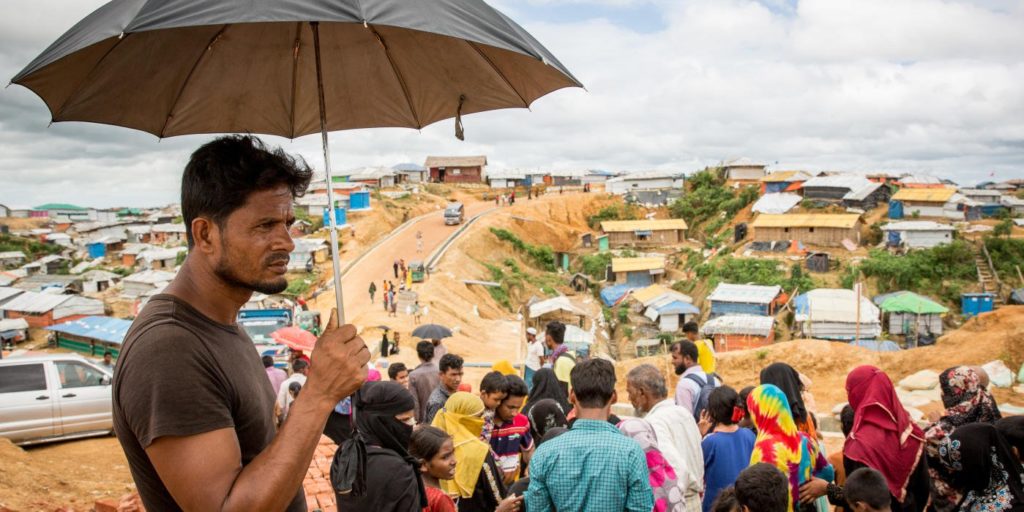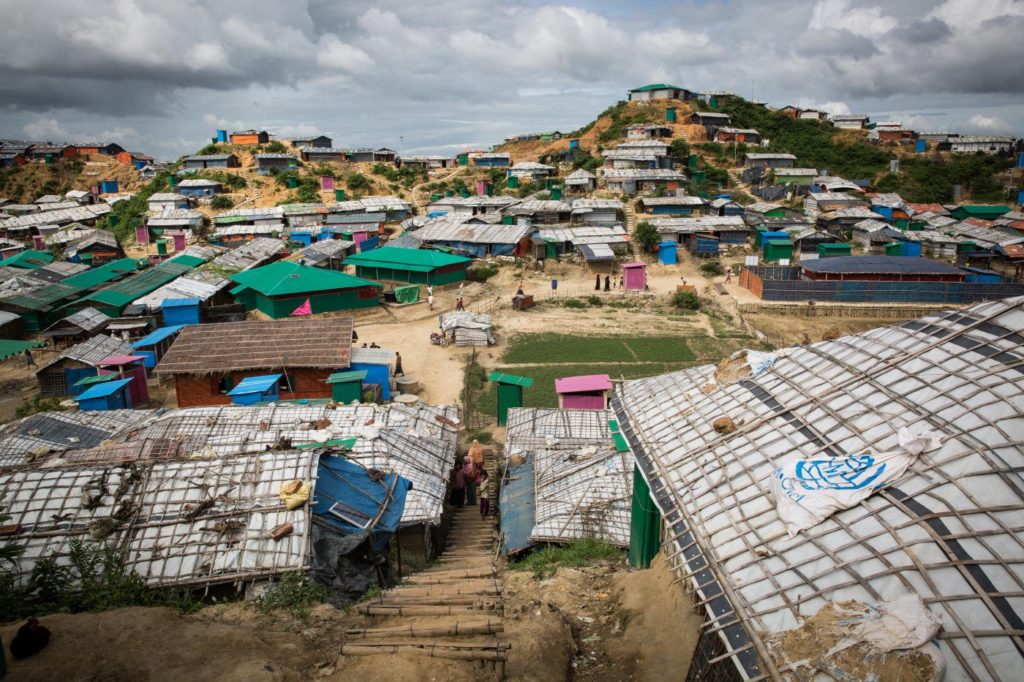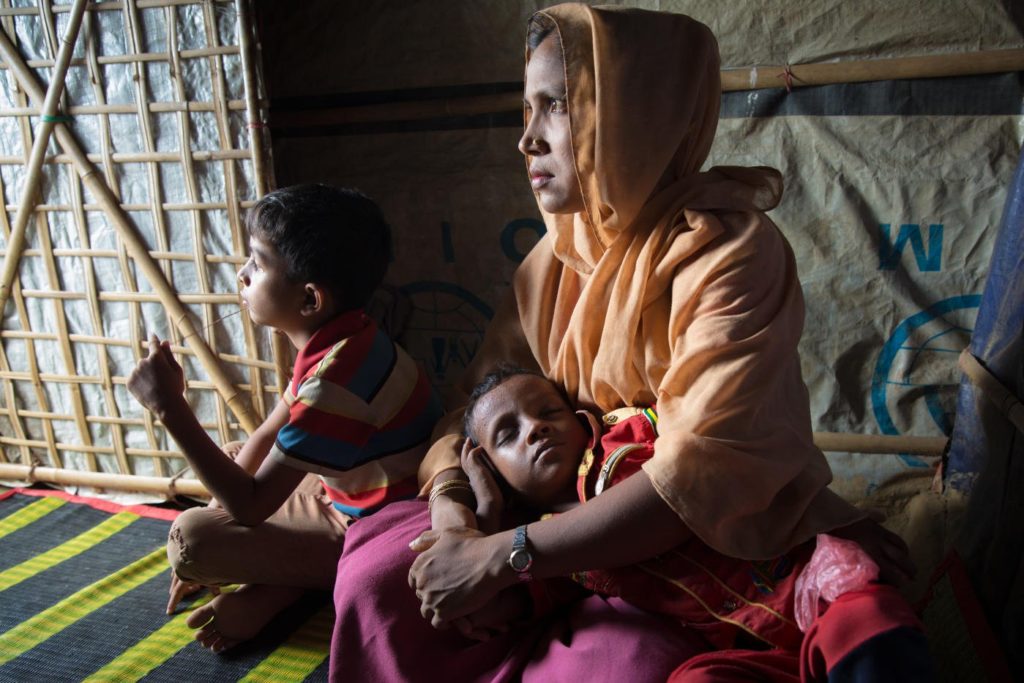Cox’s Bazar: The World’s Largest Refugee Settlement
ASIA-UPDATES ON MYANMAR ROHINGYA GENOCIDE, 27 Aug 2018
Kristine Kolstad | Norwegian Refugee Council – TRANSCEND Media Service
The mass human exodus that began last autumn from Myanmar to Bangladesh has turned Cox’s Bazar into the world’s largest refugee settlement.

Refugee Nurul Amin, 35, watches families arrive in the mega refugee camp of Kutupalong, Cox’s Bazar. They are on their way from the UN transit centre to their new homes inside the camp.
Photo: Ingebjørg Kårstad/NRC
24 Aug 2018 – “When the Myanmar military attacked my home, I lost four of my closest family members; my father, my brother, my sister and one of my nephews. Everything I owned was burned down – I’ve lost everything,” says Nurul Amin, 35, a refugee in Cox’s Bazar. He arrived with his family a year ago.
In August of last year, extreme violence erupted in Myanmar’s Rakhine State, forcing hundreds of thousands of civilians to flee their homes. One year has passed, and around 725,000 refugees from Myanmar have sought safety in neighbouring Bangladesh, according to the UNHCR.

The refugee settlement in Cox’s Bazaar, Bangladesh, is built on sandy hills where there once used to be forests. The hilly landscape is a challenging area to house hundreds of thousands of refugees.
Photo: Ingebjørg Kårstad/NRC
Like Nurul Amin, the majority of refugees in Cox’s Bazar belong to the Rohingya, a Muslim minority group.
Several other people were injured in the attack on his village, so the flight to safety in Bangladesh took 12 long days and nights. They hid for days in the mountains and forest, terrified of the military.
“I will not return with my family before we feel completely safe.”
— Nurul Amin, a refugee in Cox’s Bazar
The fear of returning
Amin feels safer now, but the transition from a comfortable life back home to life in an overcrowded refugee camp has been hard. Work is almost impossible to find and educational opportunities for his four children are limited. Despite these hardships, he is not ready to return.
“I will not return before Rohingyas get citizenship, equal rights, free movement and compensation for the houses they burned down and my land,” he says.
An overwhelming need
In total, around 900,000 refugees from Myanmar are currently sheltering in Bangladesh, and humanitarian organisations are overwhelmed by the vast scale of needs. In addition, more than half of the Rohingya refugees in the camps are children.
The humanitarian emergency worsened at the onset of the monsoon season in June, with heavy rain, high winds, flooding and landslides damaging the refugees’ shelters. Despite the ongoing relocation of people to safer ground, the camps in Cox’s Bazar are still severely overcrowded, with only 10.7 square metres per person. An area expansion is desperately needed to shelter the refugees, but achieving that remains a major challenge in one of the most densely populated countries in the world.
“We urgently need to scale up the support. The international community must shoulder more of the enormous responsibility that the Bangladeshi authorities and local communities have taken on, as well as show persecuted Rohingya refugees they are not forgotten.”
— Jan Egeland, General Secretary of the Norwegian Refugee Council (NRC)
Our expert deployment capacity team, NORCAP, have been engaged in Cox’s Bazar since the mass human exodus last autumn. So far, more than 40 relief experts have been deployed, contributing their expertise to areas such as shelter, water and sanitation facilities, education and medical aid. They are supporting the UN and local authorities’ efforts to build latrines multipurpose stalls and where people can wash themselves, give children education and help survivors of rape and sexual violence.

Janoara fled from Myanmar in late August 2017 after the military attacked her village, killed her grandfather and torched her house. She only managed to grab her two sons, Saifula (8) and Mohammed Hossein (3) before running for safety.
Photo: Ingebjørg Kårstad/NRC
Single women fear for their safety in the camps
Janoara fled from Myanmar in late August, 2017 after the military attacked her village, killed her grandfather and torched her house. She only managed to grab her two sons, Saifula, 8, and Mohammed Hossein, 3, before running for safety. Her husband had left the country for Bangladesh previously, but she has not been able to find him, so now she takes care of her two sons alone. Being a single mother in the camp is hard, and she is struggling to manage.
“I have not cooked any food for my children today. I do not feel safe enough to go out and collect firewood. I exchanged some food items for fuel, but now I do not have enough to eat.”
Janoara is in touch with family members who stayed behind in Myanmar and they are advising her not to return.
“I am not ready to return before Rohingyas gets citizenship and I can return to my land in safety.”
__________________________________________________
Related news:
22 Aug 2018 – Rohingya refugees left in limbo one year on: Aid funding for refugee relief is running out while conditions are still not in place for the safe return of over 700,000 people forced to flee Myanmar to neighbouring Bangladesh after violence broke out one year ago, warns the Norwegian Refugee Council.
15 Aug 2018 – Women’s inclusion in Myanmar’s present and future: While working toward ending seven decades of conflict, women’s inclusion will increase the chances of peace in Myanmar.
27 Jun 2018 – Securing land rights for the displaced in Myanmar: As a result of civil conflicts, large sections of the Kachin community in Myanmar have been displaced from their homes since 2011.
DISCLAIMER: The statements, views and opinions expressed in pieces republished here are solely those of the authors and do not necessarily represent those of TMS. In accordance with title 17 U.S.C. section 107, this material is distributed without profit to those who have expressed a prior interest in receiving the included information for research and educational purposes. TMS has no affiliation whatsoever with the originator of this article nor is TMS endorsed or sponsored by the originator. “GO TO ORIGINAL” links are provided as a convenience to our readers and allow for verification of authenticity. However, as originating pages are often updated by their originating host sites, the versions posted may not match the versions our readers view when clicking the “GO TO ORIGINAL” links. This site contains copyrighted material the use of which has not always been specifically authorized by the copyright owner. We are making such material available in our efforts to advance understanding of environmental, political, human rights, economic, democracy, scientific, and social justice issues, etc. We believe this constitutes a ‘fair use’ of any such copyrighted material as provided for in section 107 of the US Copyright Law. In accordance with Title 17 U.S.C. Section 107, the material on this site is distributed without profit to those who have expressed a prior interest in receiving the included information for research and educational purposes. For more information go to: http://www.law.cornell.edu/uscode/17/107.shtml. If you wish to use copyrighted material from this site for purposes of your own that go beyond ‘fair use’, you must obtain permission from the copyright owner.
Read more
Click here to go to the current weekly digest or pick another article:
ASIA-UPDATES ON MYANMAR ROHINGYA GENOCIDE: